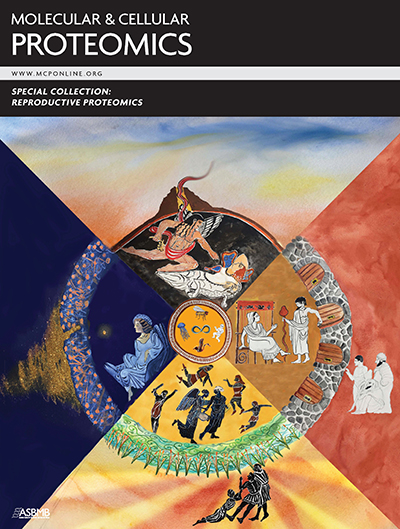MCP: A spotlight on reproductive proteomics
In a collection of articles highlighting recent discoveries in sperm and egg biology, a special issue of the journal Molecular & Cellular Proteomics celebrates the contribution of the field of proteomics to a deeper understanding of reproductive biology.
 The Molecular & Cellular Proteomics special issue cover by artist Julie Newdoll illustrates the diversity of reproductive systems in the animal kingdom.Julie Newdoll
The Molecular & Cellular Proteomics special issue cover by artist Julie Newdoll illustrates the diversity of reproductive systems in the animal kingdom.Julie Newdoll
Edited by MCP Associate Editor Tim Karr of the Biodesign Institute at Arizona State University, the issue showcases the versatility and multiplicity of proteomic technologies for analysis of protein abundance, post-translational modifications, protein–protein interactions and subcellular localization in reproduction.
According to Karr, proteomic approaches are particularly well-suited to studying reproductive biology.
“Sexual reproduction in many cases can be thought of as cellular action at a distance, that is, sperm travels outside the body in which it was produced,” Karr said. “Therefore, we can expect that a majority of interactions and interesting biology takes place predominantly at the protein–protein interaction level.”
Sperm are known to transmit packaged RNAs, but compared with somatic cells, sperm are transcriptionally inactive, further highlighting the importance of protein interactions.
Proteomics is also important in the study of interactions between the male ejaculate and the female reproductive tract. There is little experimental evidence that gene expression or other gene–gene interactions play a major role once the ejaculate is delivered to the reproductive tract.
“For these cases, proteomics is a fruitful approach if one wishes to understand the molecular mechanisms involved,” Karr said.
The special issue dives into a few major themes in reproductive biology. A series of papers investigates how proteomes of reproductive cells change throughout the reproductive processes, such as spermatogenesis, sperm maturation and capacitation, and oocyte activation.
Human fertility also is explored in depth in this special issue. A few studies delineate the proteomes of infertile sperm and sperm that undergo different abstinence periods. Another study provides the first draft map of the human ovarian proteome and its extracellular matrix, which can inform the development of artificial ovaries and provide greater understanding of fertility in women.
Two papers seek to understand polyandry, a pattern of mating in which a female animal has more than one male mate. One study investigates how polyandry drives sexual selection, and another looks to understand the protein–protein interactions that mediate sperm competition dynamics and preservation.
The special issue includes studies in various organisms, from humans to insects and even crocodiles. The diversity of organisms highlights the importance of studying reproduction. One study discovered that crocodile sperm undergo capacitation, a functional maturation that was thought to be restricted to mammals. The fact that an analogous process was observed in a distant reptilian species could challenge what we know about the evolution of species.
“Sperm and egg are the only cell types for which their function is universal throughout the animal kingdom,” Karr said. “From an evolutionary viewpoint, sperm and egg are the glue that binds life, and therefore their constituent proteomes may represent our deepest links to the evolution of eukaryotic life on the planet.”
Enjoy reading ASBMB Today?
Become a member to receive the print edition four times a year and the digital edition monthly.
Learn moreGet the latest from ASBMB Today
Enter your email address, and we’ll send you a weekly email with recent articles, interviews and more.
Latest in Science
Science highlights or most popular articles

Bacteriophage protein could make queso fresco safer
Researchers characterized the structure and function of PlyP100, a bacteriophage protein that shows promise as a food-safe antimicrobial for preventing Listeria monocytogenes growth in fresh cheeses.

Building the blueprint to block HIV
Wesley Sundquist will present his work on the HIV capsid and revolutionary drug, Lenacapavir, at the ASBMB Annual Meeting, March 7–10, in Maryland.

Gut microbes hijack cancer pathway in high-fat diets
Researchers at the Feinstein Institutes for Medical Research found that a high-fat diet increases ammonia-producing bacteria in the gut microbiome of mice, which in turn disrupts TGF-β signaling and promotes colorectal cancer.

Mapping fentanyl’s cellular footprint
Using a new imaging method, researchers at State University of New York at Buffalo traced fentanyl’s effects inside brain immune cells, revealing how the drug alters lipid droplets, pointing to new paths for addiction diagnostics.

Designing life’s building blocks with AI
Tanja Kortemme, a professor at the University of California, San Francisco, will discuss her research using computational biology to engineer proteins at the 2026 ASBMB Annual Meeting.

Cholesterol as a novel biomarker for Fragile X syndrome
Researchers in Quebec identified lower levels of a brain cholesterol metabolite, 24-hydroxycholesterol, in patients with fragile X syndrome, a finding that could provide a simple blood-based biomarker for understanding and managing the condition.

